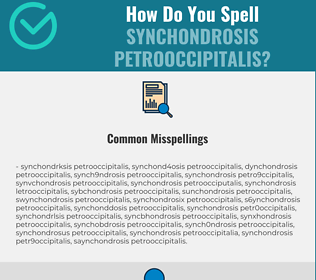SYNCHONDROSIS PETROOCCIPITALIS Meaning and
Definition
-
Synchondrosis petrooccipitalis is a specialized type of joint that connects the petrous part of the temporal bone with the occipital bone in the skull. It is a cartilaginous joint characterized by a band of fibrocartilage, known as the synchondrosis, which acts as the connecting tissue between the two bones.
The synchondrosis petrooccipitalis joint plays a crucial role in providing stability and support to the skull. Its unique structure allows for minimal movement or no movement at all, thereby ensuring the protection and proper functioning of the brain and other vital structures located within the skull.
This specific type of synchondrosis joint is located in the region where the temporal and occipital bones meet, just above the foramen magnum, which is the large opening at the base of the skull. It acts as a bridge, providing structural integrity and enabling effective transmission of forces between the two bones.
Due to its limited mobility, the synchondrosis petrooccipitalis joint primarily functions to absorb shock and distribute the mechanical load experienced by the skull during activities such as running, jumping, or even simple head movements. Its immobility also plays an essential role in ensuring proper alignment and stability of the skull to protect the delicate structures within.
In summary, synchondrosis petrooccipitalis refers to the cartilaginous joint that connects the temporal and occipital bones in the skull. It provides stability, shock absorption, and structural support, contributing to the proper functioning and protection of the brain and other vital structures.
-
Fibrocartilage filling the petrooccipital fissure.
A practical medical dictionary. By Stedman, Thomas Lathrop. Published 1920.
Common Misspellings for SYNCHONDROSIS PETROOCCIPITALIS
- aynchondrosis petrooccipitalis
- zynchondrosis petrooccipitalis
- xynchondrosis petrooccipitalis
- dynchondrosis petrooccipitalis
- eynchondrosis petrooccipitalis
- wynchondrosis petrooccipitalis
- stnchondrosis petrooccipitalis
- sgnchondrosis petrooccipitalis
- shnchondrosis petrooccipitalis
- sunchondrosis petrooccipitalis
- s7nchondrosis petrooccipitalis
- s6nchondrosis petrooccipitalis
- sybchondrosis petrooccipitalis
- symchondrosis petrooccipitalis
- syjchondrosis petrooccipitalis
- syhchondrosis petrooccipitalis
- synxhondrosis petrooccipitalis
- synvhondrosis petrooccipitalis
- synfhondrosis petrooccipitalis
- syndhondrosis petrooccipitalis
Etymology of SYNCHONDROSIS PETROOCCIPITALIS
The word "synchondrosis petrooccipitalis" is composed of two main elements: "synchondrosis" and "petrooccipitalis".
1. Synchondrosis:
- The term "synchondrosis" comes from the Greek words "syn" meaning "together" and "chondros" meaning "cartilage".
- In anatomy, a synchondrosis refers to a type of joint in which bones are connected by hyaline cartilage. It is a temporary joint that allows growth in specific areas of the skeleton during development. The cartilage eventually converts into bone as a person ages.
- The etymology of the word "synchondrosis" highlights its key characteristic of cartilaginous connection within a joint.
Infographic
Add the infographic to your website:





